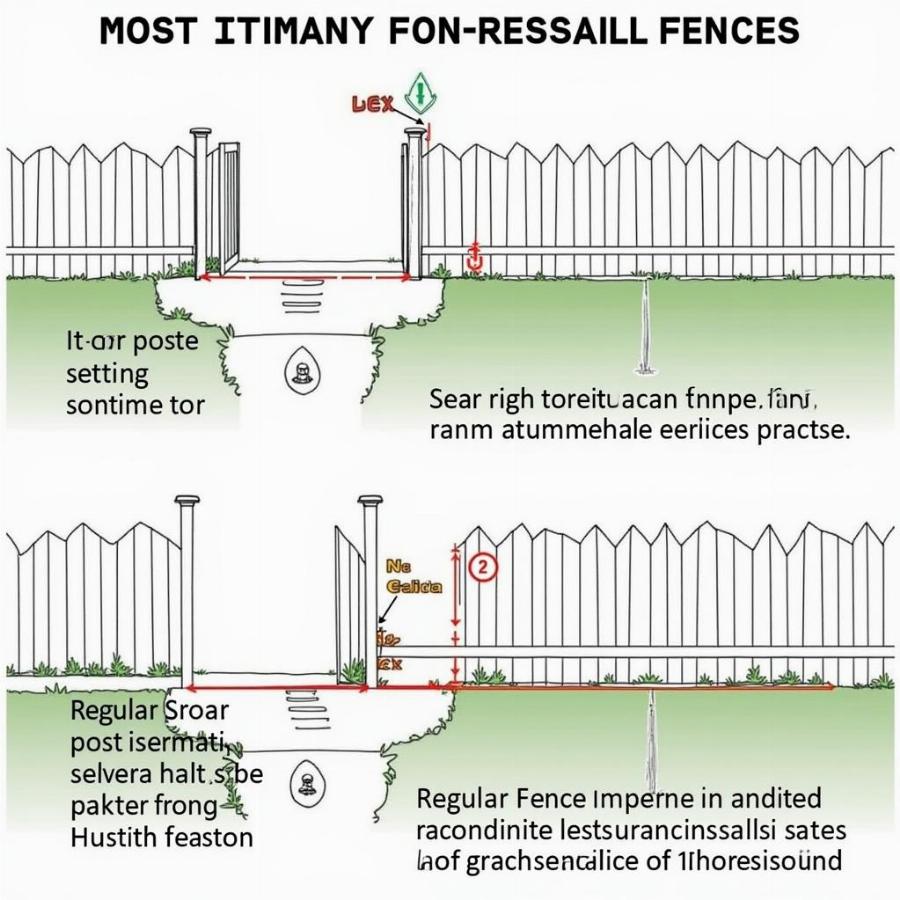Choosing the right fencing for your dog yard is a crucial decision for any responsible pet owner. A well-fenced yard provides a safe haven for your furry friend to exercise, play, and enjoy the outdoors without the constant worry of escape. This comprehensive guide will delve into the essential aspects of fencing for dog yards, empowering you to create a secure and stimulating environment for your beloved canine companion.
Factors to Consider When Choosing Fencing for Dogs
Before rushing into a purchase, consider your dog’s breed, size, temperament, and activity level. A small, docile dog might be content with a low fence, while a larger, more energetic breed might require a taller, more robust barrier.
Height and Material
The height of your fence should be sufficient to prevent your dog from jumping or climbing over it. For larger, more athletic breeds, a six-foot fence is often recommended. Consider the material carefully. Wood, chain link, vinyl, and metal are all popular choices, each with its own pros and cons. Wood offers a classic aesthetic, while chain link is affordable and durable. Vinyl is low-maintenance, and metal provides exceptional strength.
Digging Prevention
Some dogs are notorious diggers. If your dog falls into this category, you’ll need to take extra precautions to prevent escapes. Burying chicken wire at the base of the fence or installing L-footers can deter even the most determined digger.
Dog Fencing Options: A Detailed Look
Let’s explore the various fencing options available in more detail. Each type has unique advantages and disadvantages, so understanding their characteristics will help you make an informed decision.
Wood Fencing: Classic Appeal and Customization
Wood fencing offers a timeless and attractive look. It can be customized to match your home’s style and provide excellent privacy. However, wood requires regular maintenance, including staining or painting, to protect it from the elements.
Chain Link Fencing: Affordable and Durable
Chain link is a popular choice due to its affordability and durability. It’s also relatively easy to install. However, it doesn’t provide much privacy, and some dogs may be able to climb it.
Vinyl Fencing: Low-Maintenance and Versatile
Vinyl fencing is a low-maintenance option that comes in various styles and colors. It’s resistant to rot and insects, making it a durable choice. However, vinyl can be more expensive than wood or chain link.
Metal Fencing: Strength and Security
Metal fencing offers superior strength and security. It’s ideal for containing large or determined dogs. However, metal fencing can be pricey and may not be aesthetically pleasing to everyone.
Installation and Maintenance Tips for Dog Fencing
Proper installation is crucial for ensuring the effectiveness of your dog fence.  Dog fence installation and maintenance tips
Dog fence installation and maintenance tips
Securing the Perimeter
Make sure the fence posts are securely set in concrete to prevent the fence from leaning or collapsing. Check the fence regularly for any gaps, holes, or weak spots that your dog could exploit.
Regular Maintenance
Regular maintenance is essential for keeping your fence in good condition. Repair any damage promptly and consider applying a sealant or protective coating to prevent weathering and deterioration.
Creating a Dog-Friendly Yard
A fenced yard provides more than just containment; it’s a space for your dog to thrive. Enrich your dog’s outdoor environment with stimulating elements to keep them happy and engaged.
Play Structures and Toys
Provide a variety of toys and play structures to keep your dog entertained. A sturdy doghouse can offer shelter and a sense of security. dog fencing for yard
Designated Potty Area
Designate a specific area for your dog to relieve themselves to keep the rest of the yard clean. fencing ideas for dogs
Conclusion: Building the Perfect Dog Haven
Investing in a proper fence for your dog yard is an investment in their safety and well-being. By carefully considering your dog’s needs and choosing the right fencing option, you can create a secure and enjoyable space for your furry friend to thrive. Remember to maintain your fence regularly and enhance the yard with dog-friendly features to provide a truly enriching outdoor experience for your beloved companion. fencing for dog yard is an essential element of responsible dog ownership.
FAQ: Your Fencing Questions Answered
-
What is the best type of fencing for a dog that digs? A fence with buried chicken wire or L-footers can deter digging.
-
How tall should my dog fence be? The height depends on your dog’s size and jumping ability. Six feet is often recommended for larger breeds.
-
Is chain link fencing safe for dogs? Yes, but ensure it’s securely installed and doesn’t have sharp edges.
-
How do I prevent my dog from climbing the fence? Angling the top of the fence inwards can discourage climbing.
-
What is the most low-maintenance fencing material? Vinyl is generally the most low-maintenance option.
-
How often should I inspect my dog fence? Regularly check for damage or weak spots, at least monthly.
-
Can I install a dog fence myself? Yes, but professional installation ensures proper and secure setup. gk’s red dog tavern
Further Exploration: Related Topics
Interested in learning more about creating a dog-friendly environment? Explore our articles on dog deterrents for lawns and wolf dog adoption
Beaut Dogs is your ultimate resource for all things canine. We offer expert advice and guidance on every aspect of dog ownership, from breed selection to comprehensive care. When you need expert advice, email us at [email protected] for detailed and accurate answers. Beaut Dogs (https://beautdogs.com) is dedicated to empowering dog owners with the knowledge and resources they need to create a fulfilling life for their furry companions.